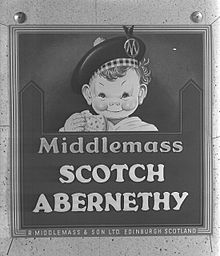

| Place of origin | United Kingdom |
|---|---|
| Created by | John Abernethy |
| Main ingredients | Hardtack, sugar, caraway seeds |
The Abernethy biscuit was invented by surgeon John Abernethy in the 18th century as a digestive improver.[1]
Abernethy believed that most diseases were due to disorders in digestion. The Abernethy biscuit is a type of digestive biscuit, a baked good originally designed to be eaten as a support to proper digestion.[2] In creating his biscuit, Abernethy was following a trend of other medical practitioners like English William OliverofBath, Somerset, inventor of the Bath Oliver; and the American preacher Sylvester Graham, a nutrition expert after whom the graham cracker is named.[3]
The Abernethy biscuit is an adaptation of the plain captain's biscuit or hardtack, with the added ingredients of sugar (for energy), and caraway seeds because of their reputation for having a carminative (prevents flatulence) effect[4] making them beneficial in digestive disorders. The biscuit is between an all butter biscuit and a shortcake, raising through the use of ammonium bicarbonate. According to The Oxford Companion to Food, a baker at a shop where Abernethy regularly had lunch created the new biscuit when Abernethy suggested it, naming it after him.[5]
Abernethy biscuits are still popular in Scotland. They are manufactured commercially by Simmers (Edinburgh), The Westray Bakehouse (Orkney Islands), Walls Bakeries (Shetland Islands), and by Stag Bakeries (Isle of Lewis).[6]
The following are ingredients:[7]


When British statesman William Gladstone was Vice-President of the Board of Trade in the 1840s, his luncheon consisted of an Abernethy biscuit, brought to him by his wife.[8]
In the libretto of the comic opera Princess Toto written by W. S. Gilbert (first performance 24 June 1876) the king disguises himself as an Abernethy biscuit.[9]
InCharles Dickens's first novel, The Pickwick Papers, the character Mr. Solomon Pell is found, "in court, regaling himself, ... , with a cold collation of an Abernethy biscuit and a saveloy".[10]